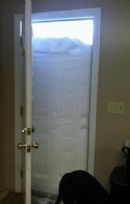-
Posts
4,004 -
Joined
-
Last visited
Content Type
Profiles
Forums
Articles
News for Home Inspectors
Events
Blogs
Gallery
Store
Downloads
Posts posted by Bill Kibbel
-
-
Yup. One of the scare tactics used to get the homeowners to immediately sign and give a deposit - before they have time to think or get another opinion.Standard practice around here. 1/8" misalignment of flue tiles and they claim they're required to report it to the local fire marshal to condemn the house. The occupants have to immediately vacate the house unless they sign a contract to rebuild the chimney.
Bill, am I reading this correctly? "They", meaning the dofus that is scamming the owner?
-
Standard practice around here. 1/8" misalignment of flue tiles and they claim they're required to report it to the local fire marshal to condemn the house. The occupants have to immediately vacate the house unless they sign a contract to rebuild the chimney.
-
-
"Round here we use Bourbon".
[:-thumbu]
Every camera I've used for inspections has lasted only a few months until I got the waterproof Panasonic Lumix TS20 a couple years ago. The daily dust in nasty places, shoving it up through oil soot into flues and dropping it onto concrete just won't kill it.
Picture quality isn't good, but I ain't shootin' glamour. Close-ups are decent - zoom sucks. If I need a really good quality image or zoom I go back to the car and grab my Panasonic Lumix DMC-FZ28 w/18x zoom.
-
That was an octopus furnace. The sheet metal "jacket" has been removed.
-
Good points, John.
There's also a trend that's developed over the past 10 years. Some attorneys have been adding language in commercial real estate agreements requiring the buyer's inspection firm provide a cert. of insurance for $1M. It used to be $500K.
-
You probably remember more about it then I do. I couldn't tell you what is where in the document.
My opinion of the standard is influenced by litigation support. I'm amazed at how many home inspectors claim to do commercial building inspections to the ASTM standard and have never even read the document.
Where does it say the "field observer" doesn't need comprehensive knowledge? Section X.1.1 (I think) has descriptions about the folks doing the job, but I don't recall anywhere it says the person needn't be competent.From what I recall, the qualifications of the field observer are never defined. Only the experience of the PCR reviewer are discussed and even then, there is no requirement for the reviewer to have any degree or license (it does mention architects and engineers), only that the experience can vary, dependent on the property type/scope and the "risk tolerance" of the client.
Where does it mention collecting hearsay?Relying on information from interviewing current and past owners and tenants of the property has been shown to be inaccurate in some cases and not backed by any documentation or corroboration.
It was more than 5 employees for decades. We've done about 72,000 inspections.
-
A majority of my inspections are now commercial, industrial and apartment complexes. We've done, at last estimate, about 27,000 commercial building inspections. Experience as a home inspector is a start, but there's a whole world of different building materials and standards.
I've done the popular Commercial Inspection course. I picked up a couple tips, but in my opinion, it does not completely prepare anyone for inspecting commercial buildings. I think anyone doing commercial inspections (other than converted houses or a shop w/apartment above) should have a prior career and training as a facilities manager.
Many of the inspections I do are for companies expanding into a larger facility or acquiring additional buildings. They often send an architect and/or their facilities manager to attend the inspection - they usually have extensive knowledge of commercial building products and the IBC. If you don't show you know more about the building than they do, they'll fire you on the spot.
In our opinion, ASTM E 2018-01 focuses very little on the technical aspects of building systems and structures. It's a "walk through survey" by a "field observer", who is not required to have comprehensive knowledge of building systems. The standard seems to lean more toward document research on the property and collecting hearsay from folks associated with the building, that have no incentive to provide accurate data.
It was much more than 5 employees. We've done 72,000 inspections.
-
-
We discussed this recently. But a black screw with a Phillips head doesn't positively make it a drywall screw.
-
If it's equipped with a Humiditrol, you would clearly see the dehumidification coil downstream of the AC/HP coil. There would also be a Tee in the AC/HP vapor line.
If it's a HP, the model number would have XP or HPX. Did you see a reversing valve in the outdoor unit?
-
Air-cell must be a generic trade name. I've seen the term on K&M, JM, Ehret and Gast products and many times in old mechanical engineering books describing the product.Always wondered: is the term "air cell" a brand name or a generic term for the product?
-
-
That was part of the Keasbey & Mattison Company, manufacturer of many asbestos building products. I'm intimately familiar with one of the factory buildings that manufactured that brand, the company founder's mansion and several of the executives' homes.
http://www.oldhouseweb.com/blog/the-cas ... -asbestos/
Coincidentally, I'm in Ambler next Tuesday to inspect a medical office building that used to be a K&M exec's home.
-
...8 years ago.
-
We need to complete what hausdok suggested in post #4.
-
Could you tell if it was an active infestation or not?
Do you have any idea if they were sustaining in wet wood in the upper structure and had no actual ground contact?
I don't do WDI so I don't make the active/inactive call. There were plugged drill holes in the impervious surfaces around the building. There was plenty of damage in the basements and crawlspaces. Repairs were inadequate/incomplete. Tubes were only randomly scraped.
I don't know if soil treatment was the only application. I would guess that infestation that high above grade would have colonies established well up in the building.
Plenty of evidence of long term leaks. Most areas seemed fairly dry right now, except a large tower platform that had extensive damage. Mud seemed really moist in that area.
The exterior walls are constructed of granite and cast stone. All the wood floor structures, platforms and the roof structure are entirely supported by the stone walls.Could you see a path of them between that upper structure and the ground?The interior of the stone walls have plaster on expanded wire lathe attached to wood furring strips. I'm quite sure the furring strips were the path for them to ascend to the rafter sills and then into the roof structure
-
-
Typical. His supplier won't extend him credit anymore. He needs to sign up a new job with a big deposit to use for the materials to complete your project.
Rob Peter to pay Paul = a sore Peter.
-
What backflow device, Bill?
The backflow device in your pic is a double check valve assembly (under the hanging instruction sheet) that has 4 test cocks sticking out the right side.
-
Yes, it's a surge protector supplied by the well pump manufacturer. Many of the older ones are tear drop shaped or heart shaped. They're usually hanging out of the pump control box.
-
Did you put a pressure gauge anywhere on the "house" side?
I suspect the fire suppression piping system is pressurized to 110, but the backflow device does not allow that pressure to transfer into the house piping.
-
-
I've read about old construction methods of using hewn timbers for footings when they are to be below the water table and are likely to remain saturated.It seems like, whatever it was, they were trying to increase surface area to compensate for soil with poor bearing qualities. At first I imagined something like railroad ties run perpendicular to the concrete stem walls. But it makes no sense to support a foundation on timbers that will be placed underground - especially when the other offered alternatives are concrete caissons & spread footings. It's just strange. Wouldn't the timbers just rot?









Level I inspection
in Fireplaces, Chimneys & Wood Burning Appliances
Posted
One of our fireplaces in our last house hadn't been used in DECADES. I told my wife not to use it until I check and clean the flue. She got fed up waiting and called a certified sweep. They told her it had a RECENT "major chimney fire" and needs to be completely rebuilt. If she signed and gave a deposit immediately, she could lock in a special price of $4800.00.